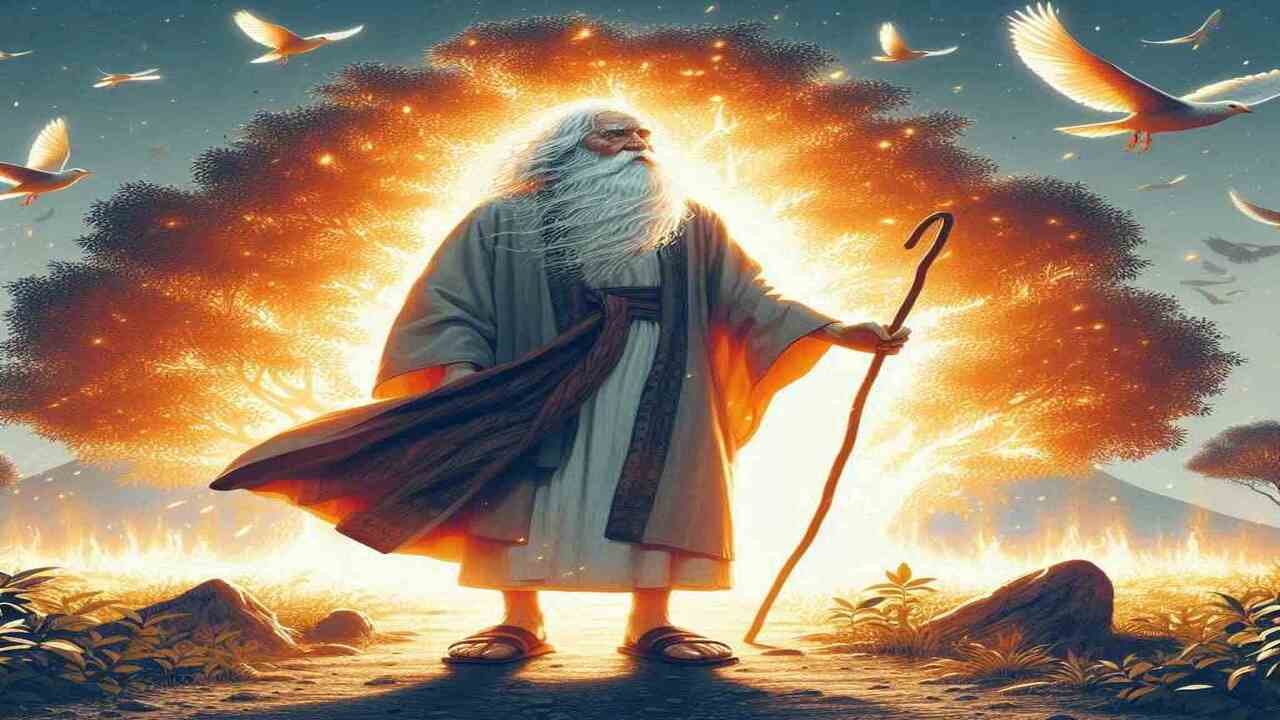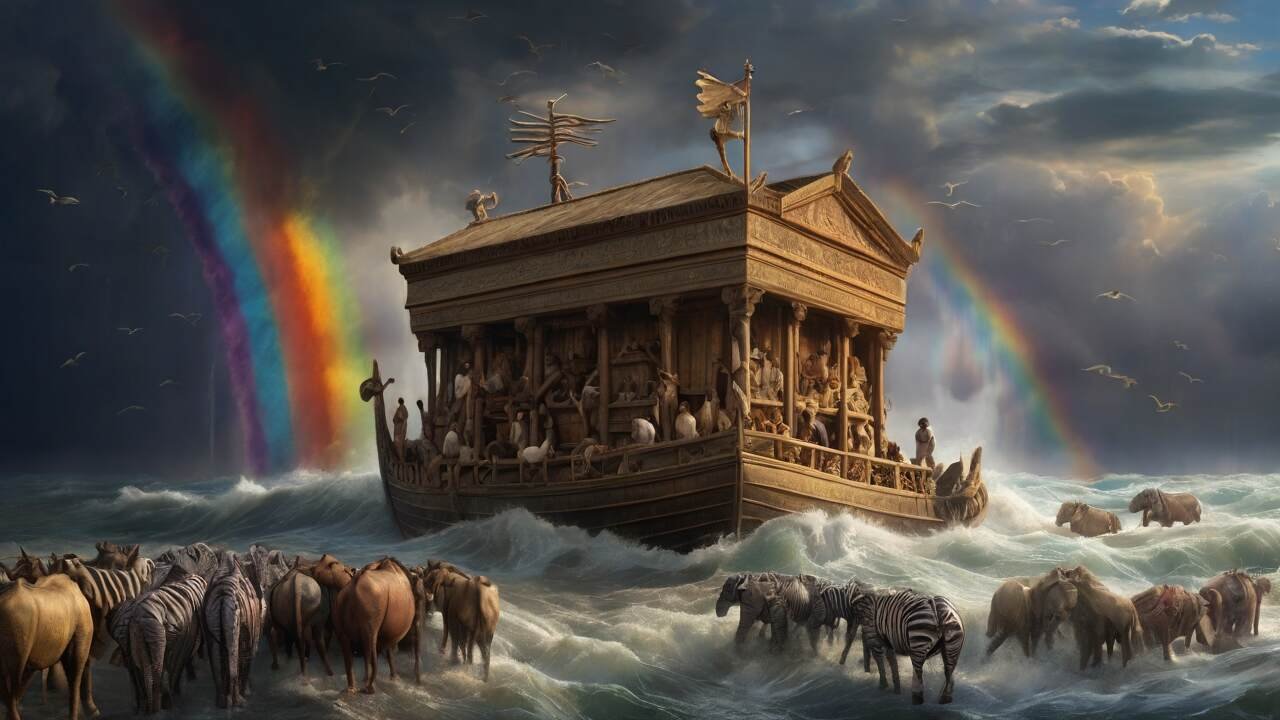The story of God speaking to Moses out of the burning bush is a profound biblical narrative that reveals the divine encounter between the Almighty and His chosen servant. This remarkable event, recounted in Exodus 3:1–4:23, takes place on the slopes of Mount Horeb, where Moses experiences a theophany—the appearance of God in a visible form. The burning bush, as described in Exodus 3:2, serves as a symbolic representation of God’s presence, serving as a powerful reminder of His holiness, glory, and compassion for His suffering people.
Key Takeaways
- The story of Moses and the burning bush demonstrates God’s presence and self-revelation to His chosen servant.
- The burning bush is a theophany, a visible appearance of God, revealing His holiness and glory.
- God’s compassion for His suffering people is manifested in His calling of Moses to deliver the Israelites from Egyptian bondage.
- The narrative of the burning bush underscores the eternal and self-existent nature of God, who is the “I AM” (Exodus 3:14).
- The story foreshadows God’s ultimate redemptive purpose, which is fulfilled through the life, death, and resurrection of Jesus Christ.
The Encounter at the Burning Bush
The story of Moses and the burning bush in Exodus 3 is a profound theophany, a divine revelation that demonstrates God’s presence in a remarkable way. This encounter not only reveals the holiness and glory of the Almighty but also sets the stage for God’s redemptive plan for His suffering people.
The Significance of the Burning Bush in Exodus 3
The burning bush is a significant symbol in the biblical narrative, as it represents God’s divine revelation to Moses. This event marked a turning point in the life of Moses, as he was called by God to lead the Israelites out of their oppression in Egypt. The fact that the bush was on fire, yet not consumed, underscores the holiness of God, who is able to manifest His presence without destroying His creation.
God’s Revelation of His Holiness and Glory
In this encounter, God revealed Himself to Moses in a way that had never been seen before. The text states that “the angel of the Lord appeared to him in a flame of fire out of the midst of a bush” (Exodus 3:2), and when Moses approached, God declared, “Do not come near; take your sandals off your feet, for the place on which you are standing is holy ground” (Exodus 3:5). This theophany not only showcased God’s holiness but also His glory, as the entire scene was a powerful display of the divine presence.
“Who is like you, O Lord, among the gods? Who is like you, majestic in holiness, awesome in glorious deeds, doing wonders?” (Exodus 15:11)
This quote from Moses’ famous victory hymn reflects the profound impact of the burning bush encounter, where Moses experienced the holiness and glory of God in a way that would shape the rest of his life and ministry. The story of the burning bush stands as a powerful testament to God’s presence and His desire to reveal Himself to His people.
God’s Compassion for His Suffering People
The story of Moses and the burning bush reveals the profound compassion of God for His suffering people. Under the oppressive bondage of Egypt, the Israelites had no hope but to cry out to God (Exodus 3:7-8). And God heard their cries, declaring that He had “seen the affliction of my people who are in Egypt” and was now ready to deliver them from their enslavement and suffering.
This divine compassion was the first step in God’s redemptive plan for His chosen people. Though He had previously revealed Himself as the one who dwells in unapproachable light (1 Timothy 6:16), the burning bush symbolized His intent not to consume or destroy His people, but to be their savior (Psalm 40:17; Isaiah 41:10; Jeremiah 1:8).
“I have surely seen the affliction of my people who are in Egypt and have heard their cry because of their taskmasters. I know their sufferings, and I have come down to deliver them out of that land and to bring them up out of that land to a good and broad land, a land flowing with milk and honey.”
This powerful display of divine compassion and God’s desire to redeem His suffering people from bondage is a central theme in the story of Moses and the burning bush. It demonstrates how the story of Moses and the burning bush reveals God’s presence and His commitment to suffering and redemption.
Through this encounter, God was making it clear that He had not abandoned His people, but was actively engaged in their struggle and ready to intervene on their behalf. This foreshadowed the ultimate act of divine compassion – the sending of His Son, Jesus Christ, to deliver humanity from the bondage of sin and death.
How does the story of Moses and the burning bush demonstrate God’s presence?
The story of Moses and the burning bush in Exodus 3 is a powerful demonstration of God’s divine self-revelation and His enduring presence with His people. Through this miraculous encounter, we gain valuable insights into the meaning of God’s name and the symbolic significance of the burning bush.
God’s Self-Revelation and the Meaning of His Name
In this story, God reveals Himself to Moses in a remarkable way. When Moses asks for God’s name, the Almighty declares, “I AM WHO I AM” (Exodus 3:14). This profound statement speaks to God’s eternal, self-existent nature. The name “I AM” conveys the idea that God is the one who simply is, without beginning or end, the source of all existence. By identifying Himself in this way, God communicates the depth of His divine presence and the meaning behind His personal name, Yahweh.
The name “Yahweh,” derived from the Hebrew verb “to be,” underscores God’s unchanging and ever-present nature. He is the God who was, who is, and who will be, the same yesterday, today, and forever. This self-revelation of God’s name demonstrates His desire to be known and encountered by His people in a personal way.
The Burning Bush as a Symbol of God’s Presence
The burning bush itself serves as a powerful symbol of God’s presence and His relationship with His people. Though the bush was on fire, it was not consumed, a miraculous sign that God’s holiness and glory did not destroy but rather sought to redeem and protect His chosen people. The burning bush represents God’s intent to dwell with His people, to lead them out of bondage, and to fulfill His promises.
This divine encounter at the burning bush was a profound moment of God’s self-disclosure, where He revealed His personal name and His desire to be intimately involved in the lives of His children. The story of Moses and the burning bush powerfully demonstrates that the Almighty God is not distant or detached, but rather close, personal, and actively engaged in the lives of those who seek Him.
“I AM WHO I AM.” This is what you are to say to the Israelites: “I AM has sent me to you.”” (Exodus 3:14)
The Eternal and Self-Existent God
The story of Moses and the burning bush powerfully demonstrates the presence of God, revealing His eternal and self-existent nature. By identifying Himself as “I AM,” the Almighty declares that He exists in the immediate now, transcending the constraints of time that bind humanity.
God is not limited by a fixed point of origin or a predetermined end. He has no beginning or end, for He has always been and will always be. As the Alpha and Omega, the First and the Last (Revelation 22:13), the eternal and self-existent God stands outside the confines of time, His divine attributes defying our finite understanding.
This profound revelation of God’s eternal and self-existent nature is central to the story of Moses and the burning bush. It underscores the fundamental truth that the God of Israel is not merely a distant, impersonal force, but a living, active, and all-powerful Being who remains ever-present with His people.
“I am who I am.” (Exodus 3:14)
Through this simple yet profound declaration, God affirms His eternal and self-existent nature, transcending the limitations of time and space. As Moses stands before the burning bush, he encounters the divine presence of the one true God, who calls him to a pivotal role in the redemption of His chosen people.
The story of the burning bush not only reveals the eternal and self-existent nature of God but also demonstrates how His divine presence can intersect with the lives of those who seek Him. This timeless narrative invites us to consider the profound implications of a God who stands outside the constraints of time, yet actively engages with His creation.
God’s Redemptive Purpose Revealed
The story of Moses and the burning bush demonstrates God’s unwavering presence and His redemptive purpose for His people. Through this pivotal encounter, the God of Abraham, Isaac, and Jacob revealed His intention to deliver the Israelites from their bondage in Egypt and lead them to the Promised Land.
God’s Promise to Deliver Israel from Egypt
As Moses encountered the burning bush, God proclaimed, “I have indeed seen the misery of my people in Egypt. I have heard them crying out because of their slave drivers, and I am concerned about their suffering.” (Exodus 3:7) This declaration underscores God’s compassion for His people and His determination to act on their behalf. The burning bush symbolized God’s presence, and through it, He revealed His plan to confront the oppressive power of Pharaoh and orchestrate the redemption and deliverance of the Israelites from the shackles of Exodus.
God further assured Moses, “So I have come down to rescue them from the hand of the Egyptians and to bring them up out of that land into a good and spacious land, a land flowing with milk and honey.” (Exodus 3:8) This promise of redemption and deliverance from oppression, and the subsequent journey to the Promised Land, would become the central narrative of the book of Exodus.
“I have indeed seen the misery of my people in Egypt. I have heard them crying out because of their slave drivers, and I am concerned about their suffering. So I have come down to rescue them from the hand of the Egyptians and to bring them up out of that land into a good and spacious land, a land flowing with milk and honey.” (Exodus 3:7-8)
Through this extraordinary encounter, God revealed His redemptive purpose and His desire to liberate His people from their bondage. The story of Moses and the burning bush serves as a powerful testament to God’s unwavering presence, His compassion for the oppressed, and His commitment to fulfilling His promises of redemption and deliverance.
Approaching the Holy God through Christ
The story of Moses and the burning bush reveals the holiness and glory of God, reminding us that we cannot approach the Almighty on our own. Today, the only way for us to come into the presence of a holy God is to become holy ourselves. This is why God sent Jesus to be our Savior. He is our holiness (1 Corinthians 1:30).
We could never keep God’s Law, but Jesus kept it for us with perfect holiness. When Jesus died on the cross, He took away all of our unholiness, exchanging His righteousness for our unrighteousness (2 Corinthians 5:21). When we believe in Him, God accepts us as holy—as holy as Jesus Himself. The grace that God has shown through the cross enables us to approach the Holy One—not as Moses did, hiding his face in fear, but by faith, trusting and believing in the person and work of Jesus Christ.
“For our sake he made him to be sin who knew no sin, so that in him we might become the righteousness of God.” (2 Corinthians 5:21)
Through Christ, we can now boldly approach the throne of grace, confident that we will receive mercy and find grace to help in our time of need (Hebrews 4:16). The story of Moses and the burning bush reminds us of the holiness of God, but it also points us to the salvation that Christ offers, enabling us to stand before the holy God without fear.

Conclusion
The story of Moses and the burning bush powerfully demonstrates God’s presence and reveals His divine plan for Israel’s exodus. Through this remarkable theophany, the Almighty manifests His holiness and glory, shows compassion for His suffering people, and discloses His eternal, self-existent nature. By giving Moses His personal name, “I Am,” God establishes a redemptive relationship, promising to deliver the Israelites from bondage and lead them to the Promised Land.
Ultimately, this biblical narrative points to the coming of Christ, the true Holy One through whom we can now approach the presence of the almighty God. The story of the burning bush not only showcases God’s presence but also foreshadows the ultimate redemption that would be accomplished through the life, death, and resurrection of Jesus Christ.
This divine encounter at the burning bush serves as a powerful reminder of the ever-present, compassionate, and redemptive nature of our God. As we reflect on this story, may it inspire us to seek God’s presence, trust in His promises, and recognize His work in our lives, just as He revealed Himself to Moses, guiding the Israelites to freedom and salvation.
FAQ
How does the story of Moses and the burning bush demonstrate God’s presence?
The story of Moses and the burning bush powerfully demonstrates God’s presence by revealing His divine attributes, such as His holiness, glory, compassion, and self-existence. Through this remarkable theophany, God manifests Himself to Moses, establishes a redemptive relationship, and discloses His eternal, self-existent nature.
What is the significance of the burning bush in Exodus 3?
The burning bush is a theophany, the appearance of God in a visible form. It symbolizes God’s holiness and glory, as fire is used throughout the Bible to represent the purifying and refining quality of God’s holiness. The burning bush also demonstrates God’s intent not to consume or destroy His people, but to be their savior and deliver them from bondage.
How does the story reveal God’s holiness and glory?
In the encounter at the burning bush, God reveals His holiness in a way it had never been revealed before. The burning bush and God’s command for Moses to remove his sandals because he was standing on “holy ground” emphasize the gap between the divine and the human, and God’s transcendent holiness.
How does the story demonstrate God’s compassion for His suffering people?
God reveals that He has seen the misery of His people in Egypt, heard their cries, and is concerned about their suffering. This is the first time God calls Israel “my people,” showing His compassion and intention to deliver them from their oppression and bondage.
What is the significance of God revealing His name as “I AM” to Moses?
By identifying Himself as “I AM,” God is declaring His eternal, self-existent nature. He is not bound by time like we are, having no beginning or end. This name establishes a redemptive relationship, as God promises to deliver the Israelites and lead them to the Promised Land.
How does the burning bush symbolize God’s presence and desire to dwell with His people?
Though God lives in unapproachable light, the burning bush demonstrates His desire to dwell with and redeem His people. It symbolizes God’s intent not to consume or destroy them, but to be their savior and lead them out of bondage.
How does the story of Moses and the burning bush point to the coming of Christ?
The narrative ultimately points to the coming of Christ, the true Holy One through whom we can now approach the presence of the almighty God. While Moses had to hide his face in fear, we can now approach God’s presence by faith in Jesus, who has taken away our unholiness and granted us His righteousness.








